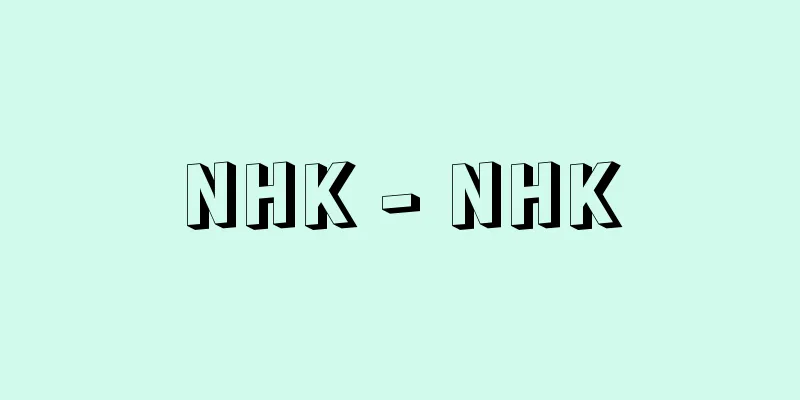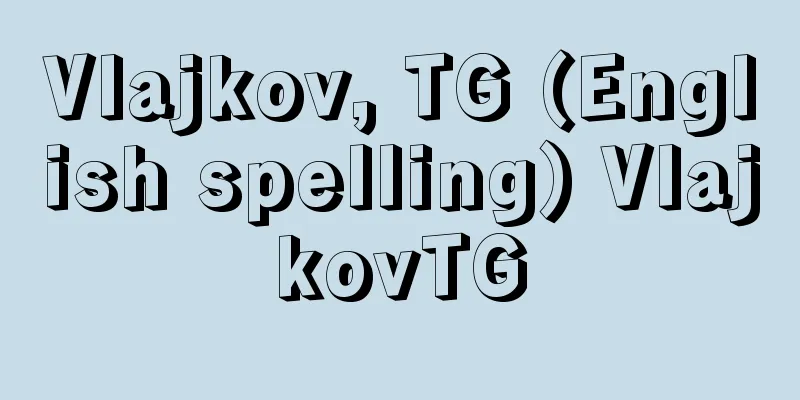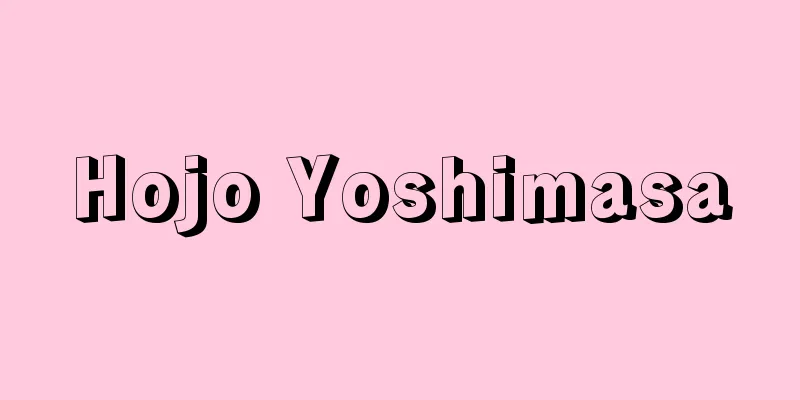NHK - NHK

|
The abbreviation for Japan Broadcasting Corporation (NHK), a public broadcasting organization based on the Broadcasting Law (Law No. 132 of 1950) whose "purpose is to broadcast for the public welfare so that it can be received throughout Japan" (Article 7 of the same law) and whose operating revenue comes from reception fees. [Goto Kazuhiko] historyThe history of NHK can be said to be the history of broadcasting in Japan. On March 22, 1925 (Taisho 14), the incorporated Tokyo Broadcasting Station began provisional broadcasting, becoming Japan's first broadcasting station (the current Broadcasting Memorial Day is named after this date). Within the same year, Osaka and Nagoya stations also opened, and the three stations developed their broadcasting businesses independently as government-chartered incorporated associations funded by reception fees. However, with the urging of the Ministry of Communications, which intended to realize a nationwide broadcasting network, the three stations were unified into the incorporated Japan Broadcasting Corporation in August 1926. In 1931 (Showa 6), the second broadcasting station (Tokyo) was launched, and educational broadcasting was enhanced. In 1934, the organization was restructured to become a central broadcasting station, and program lineups were unified nationwide. In 1935, nationwide relay of school broadcasts and overseas broadcasting to the western United States began. When the February 26th Incident in February 1936 was being resolved, the Martial Law Command broadcast a "Message to the Soldiers" (on the 29th), impressing upon the public the effectiveness of persuasion through broadcasting. In August of the same year, the Olympic Games were broadcast live from Berlin. Announcer Kasai Sansei's famous "Go Maehata!" call was made during this broadcast. By the end of May 1940, the number of radio reception contracts had topped five million. However, after the country entered World War II in December of the following year, Second Broadcasting was suspended, broadcast radio control was implemented, and weather broadcasts were discontinued; broadcasting was fully incorporated into the country's wartime system, and NHK was essentially placed under state control. At the end of the war on August 15, 1945, the Emperor took the emergency measure of broadcasting a decree (the Gyokuon-hoso), which proved extremely effective in settling the situation. During the occupation, NHK was placed under the control of the Supreme Commander for the Allied Powers (GHQ) and received direct and strong programming guidance from the Civil Information and Education Bureau's (CIE) Radio Division. GHQ placed great importance on the influence of NHK's broadcasts, which had a nationwide broadcasting network, and actively used them as a means of transmitting information to achieve the occupation's goals. This programming guidance during the occupation period led to the introduction of new programs such as "street recordings," "broadcast debates," and "quiz shows," and further led to the deep penetration of American commercial broadcasting methods in terms of direction and programming. On June 1, 1950, the Broadcasting Act came into effect, and the previous incorporated associations were dissolved, and the special corporation "Japan Broadcasting Corporation" (NHK) was established based on the Broadcasting Act, inheriting their assets. As the highest decision-making body for the management of the NHK, a Board of Governors consisting of 12 members appointed by the Prime Minister with the consent of the Diet was established. The committee represents the public and decides on NHK's basic management policies, such as its income and expenditure budget and programming plan, and appoints the chairman, who is the person in charge of daily operations. NHK's income and expenditure budget and business plan are submitted to the Diet every fiscal year, along with a statement of opinion from the Minister of Internal Affairs and Communications, for approval. The 1950 reform of the broadcasting system allowed the establishment of new commercial broadcasting stations, and from September of the following year, NHK, which had previously had a monopoly on broadcasting, was forced to compete with commercial broadcasters. In February 1952, international broadcasting was resumed in five directions, and in August of the same year, the number of radio reception contracts exceeded 10 million. In February of the following year, NHK began regular television broadcasting, the first in Japan. In December 1956, it began experimental color television broadcasting, and in December 1957, experimental FM broadcasting, and in January 1959, it launched Educational Television as a purely educational station. In September 1960, color television broadcasting became regular, and by March 1962, the number of television reception contracts had exceeded 10 million. [Goto Kazuhiko] Present and FutureNHK currently provides domestic terrestrial broadcasting through two television channels (general and educational), two AM radio channels (1 and 2), and one FM radio channel. Regular satellite broadcasting using satellite channels began in June 1989 (Heisei 1) on both Satellite 1 and 2. Furthermore, NHK has been conducting test broadcasts of high definition television since 1994, and began regular digital high definition broadcasting in December 2000. In addition, NHK also provides international broadcasting via television and radio (shortwave). There are two television channels each for Europe and North America, and for Asia and the Pacific, making it possible for international television broadcasts to be seen in almost all parts of the world. NHK has two research institutes to support this global broadcasting: the Broadcasting Technology Research Institute and the Broadcasting Culture Research Institute, which conduct research and studies in a wide range of areas from technology to social science. NHK also has 27 overseas bureaus, branch offices and representative offices, in preparation for broadcasting in this age of globalization. Most of the financial basis for these activities comes from reception fees, which amounted to 613.8 billion yen in fiscal 2006. The NHK has a staff of 11,642. Such is NHK's history and current situation, but its future is by no means easy. With the progress of major technological innovations, including digitization, the emergence of pay digital multi-channel television broadcasting using communications satellites, the proliferation of multiple cable television channels, and the expanding use of the Internet for broadcasting, NHK, with its long history, is facing increasingly severe business conditions it has never experienced before. [Goto Kazuhiko] "NHK 50 Years of Broadcasting History" (1977, Japan Broadcast Publishing Association)" ▽ "NHK Yearbook, various editions (Japan Broadcast Publishing Association)" [Reference items] | | | | | | | | | |The heart of NHK, with a site area of approximately 25,000 tsubo (82,650 m), is the site of the broadcasting center. Construction began in 1963 to relocate the facility from the Tokyo Broadcasting Hall in Uchisaiwaicho, Chiyoda Ward, Tokyo, which had been in use since 1938 (Showa 13). The entire relocation was completed in 1973. In 1964, while construction was still in progress, some of the completed facilities were used to broadcast the Tokyo Olympics. On the right in the photo is the main building, which has become the symbol of the broadcasting center. Shibuya Ward, Tokyo ©Yutaka Sakano "> NHK Broadcasting Center The world's first broadcasting museum was established by NHK on Atagoyama, the birthplace of Japanese broadcasting. It opened in 1956. The four-story building showcases the progress of broadcasting from radio, television, satellite broadcasting, high-definition television, and digital broadcasting. Minato-ku, Tokyo ©Yutaka Sakano "> NHK Broadcasting Museum Source: Shogakukan Encyclopedia Nipponica About Encyclopedia Nipponica Information | Legend |
|
日本放送協会の略称。放送法(昭和25年法律132号)に基づく特殊法人で、「公共の福祉のために、あまねく日本全国において受信できるように放送を行うことを目的」(同法7条)とし、受信料を運営財源とする公共放送事業体。 [後藤和彦] 歴史NHKの歴史はそのまま日本の放送の歴史といえる。1925年(大正14)3月22日、社団法人東京放送局が仮放送を開始、日本の最初の放送局となった(現在の放送記念日はこの日にちなむ)。同年中に大阪、名古屋も開局、三者は受信料を財源とする政府特許の社団法人として相互に独立し放送事業を展開した。しかし全国放送網の実現を意図する逓信(ていしん)省の働きかけで1926年8月、3局が一本化した社団法人日本放送協会が成立した。1931年(昭和6)には第二放送を開始(東京)、教育放送の充実を図った。1934年には機構が改められ、中央放送局制となり、番組の編成も全国的に統一されることとなった。1935年には学校放送の全国中継、アメリカ西部向け海外放送が始められた。1936年2月の二・二六事件の収拾に際しては、戒厳司令部発表の「兵に告ぐ」の放送(29日)が行われ、放送による説得の効果を国民の心に刻み込んだ。同年8月にはオリンピック大会実況をベルリンから中継した。河西三省(かさいさんせい)アナウンサーの有名な「前畑がんばれ」の放送はこの中継のときのことである。1940年5月末にはラジオの受信契約数は500万を突破した。しかし翌年12月に第二次世界大戦に突入してからは、第二放送は停止、放送電波管制の実施、気象放送中止、と放送は全面的に国の戦時体制に組み込まれ、NHKは実質的に国家管理のもとに置かれた。 1945年(昭和20)8月15日の終戦に際しては、天皇による詔勅の放送(玉音放送)という非常手段がとられ、事態の収拾に大きな効果をあげた。占領下、NHKは連合国最高司令部(GHQ)の管理下に置かれ、民間情報教育局(CIE)ラジオ課の直接的で強力な番組指導を受けた。GHQは、全国放送網を有するNHKの放送の影響力を重視し、占領目的達成の情報伝達手段として積極的に活用したのである。この占領時代の番組指導によって「街頭録音」「放送討論会」「クイズ番組」などが新たに導入され、さらに演出や編成の面にアメリカの商業放送の方式が深く浸透することになった。1950年6月1日には放送法が施行され、従前の社団法人組織は解散、その財産を受け継いで、放送法に基づく特殊法人「日本放送協会」が誕生した。その経営に関する最高の議決機関として、国会の同意を得て内閣総理大臣が任命する12名の委員からなる経営委員会が置かれることになった。同委員会は国民を代表し、NHKの収支予算、番組編成計画など経営の基本方針を決定し、また日常業務執行の最高責任者である会長を任命する。NHKの収支予算、事業計画は毎年度、総務大臣の意見書とともに国会に提出され、その承認を受ける仕組みとなっている。 1950年の放送制度改革によって新たに商業放送の設置が認められ、それまで独占的に放送を行ってきたNHKは、翌51年9月から、商業放送と競争的立場に立たされることになった。その後、1952年2月に国際放送を5方向で再開、その年の8月にラジオの受信契約数は1000万を突破した。翌1953年2月、NHKは日本で初めてテレビの本放送を開始した。さらに1956年12月にはカラーテレビの実験放送、57年12月からはFM実験放送を開始し、59年1月には純教育局として教育テレビを開局した。1960年9月にはカラーテレビが本放送となり、62年3月にはテレビの受信契約数が1000万を超えた。 [後藤和彦] 現状と将来NHKは現在、国内地上放送としてはテレビ2系統(総合、教育)、中波ラジオ2系統(第1、第2放送)、FMラジオ1系統の放送を行っている。放送衛星を利用した衛星放送は1989年(平成1)6月に衛星第1、第2ともに本放送を開始した。さらに、1994年からハイビジョン実用化試験放送を行ってきたが、2000年12月からデジタルハイビジョンの本放送が開始された。そのほかに国外向けの国際放送をテレビとラジオ(短波)で行っている。テレビはヨーロッパ・北米地域向けとアジア・太平洋地域向けにそれぞれ2チャンネルの放送が行われており、世界のほぼ全域でテレビ国際放送が見られるようになっている。 こうした世界的規模の放送の実施を支えるための調査研究機関として、NHKには放送技術研究所と放送文化研究所があり、技術面から社会科学的側面まで多方面におよぶ調査研究活動を展開している。また、海外には総局、支局、駐在、計27を配置して国際化時代の放送に備えている。それらの活動の財政基盤のほとんどは受信料収入であり、2006年度その額は6138億円である。また職員数は1万1642人である。 こうしたNHKの歴史と現状であるが、その将来はけっして容易なものとはいえない状況にある。デジタル化をはじめ大きな技術革新の進展で、通信衛星利用の有料デジタル多チャンネルテレビ放送の出現、ケーブルテレビの多チャンネル化、インターネットの放送的利用の拡大など、長い歴史をもつNHKにもいまだかつて経験のないような厳しい経営環境条件が次々加わってきているのである。 [後藤和彦] 『日本放送協会編『放送五十年史』(1977・日本放送出版協会)』▽『日本放送協会編『NHK年鑑』各年版(日本放送出版協会)』 [参照項目] | | | | | | | | | |敷地面積約2万5000坪(8万2650m)を誇るNHKの中枢。1938年(昭和13)から使用していた東京都千代田区内幸町の東京放送会館から移転するため、63年に着工。73年、全面移転が完了した。工事中の64年には、完成していた一部の施設を使用して東京オリンピックの放送を行った。写真右は、放送センターのシンボルともなっている本館。東京都渋谷区©Yutaka Sakano"> NHK放送センター NHKが日本の放送の発祥地愛宕山に設けた世界初の放送博物館。1956(昭和31)年開館。4階建ての館内では、ラジオ、テレビ、衛星放送、ハイビジョン、そしてデジタル放送へと進歩した放送の歩みを紹介している。東京都港区©Yutaka Sakano"> NHK放送博物館 出典 小学館 日本大百科全書(ニッポニカ)日本大百科全書(ニッポニカ)について 情報 | 凡例 |
<<: NHK Gakuen High School - NHK Gakuen High School
Recommend
Lime altar - Ishibai no dan
It occupies two rooms at the southern end of the ...
Yuri (lily) - Yuri
A general term for the genus Lilium, family Liliac...
Otsukabe Wall
A type of topcoat for clay walls. A mixture of co...
Lugh
…The Tuatha Dé Danann (meaning the race of the go...
Cost Management
Traditionally, it has been used to mean managemen...
Michitoshi Odauchi
1875-1954 A geographer from the Taisho and Showa ...
Espingalda - Espingalda
…European sources say that this was in 1542. The ...
Natural History - Historia naturalis
Encyclopedia by the Roman scholar Pliny. 37 volume...
Rotteck, Karl Wenzeslaus Rodecker von
Born: July 18, 1775, Freiburg Died November 26, 18...
P'ung-jang (English spelling)
Son of King Uija of Baekje, Korea. Date of birth a...
Buttress
Architectural term. A buttress is a wall that proj...
Infarction
Also written as infarction, it refers to a sudden...
Torii Yozo
Year of death: October 3, 1873 Year of birth: Nove...
Sumida River Memories - Memories of the Sumida River
A Kabuki play. Sewamono (domestic story). Four ac...
al-Iskandariya (English spelling)
…The capital of the Alexandria province in the co...








![Hasuda [city] - Hasuda](/upload/images/67cc84f31ca1f.webp)
